Problem
One’s genealogy has become a hot topic around the world, for those who want to unlock their family’s past or to keep an accurate record of their lineage. SQL Server might be a useful tool throughout this process. Is it possible to work with genealogy data in SQL Server?
Solution
Genealogy is the study of families, family history, and the tracing of their lineages. Genealogical data has gained a lot of attention recently because people are looking for their identity and belonging. Nowadays, it is increasing the accessibility of historical records that are now digitized and searchable, making the process of obtaining information about ancestors easy and fast.

In this article, we look at how we can use SQL Server to store and easily report back lineage information related to genealogy data.
Terms and Definitions
GEDCOM
GEDCOM, an acronym for Genealogical Data Communications, which was created by The Church of Jesus Christ of Latter-day Saints, in 1984, is a specification for exchanging genealogical data between different software applications. Multiple versions have since been released and copyrighted by them, including the release of version 5 in 2019, which is the most used version. In 2021, version 7 was released and is the last one, but is still being implemented.
GRAMPS
For this article, I will use GRAMPS, which is a free genealogical software project and community that is both intuitive for hobbyists and feature-complete for professional genealogists. It is a community project, created, developed, and governed by genealogists. You can download it from the GRAMPS website.
Genealogy in SQL Server
Genealogical Database Diagram (Suggestion)
If I had to propose a database diagram to hold genealogic data, I would suggest something like the diagram below. But, since this article is to discuss tools to help use genealogical data, I will use a very small and simplified database diagram with only two tables: one for Individuals and another for Couples. For the purpose of finding kindship, I will include a table to hold the ancestral path.
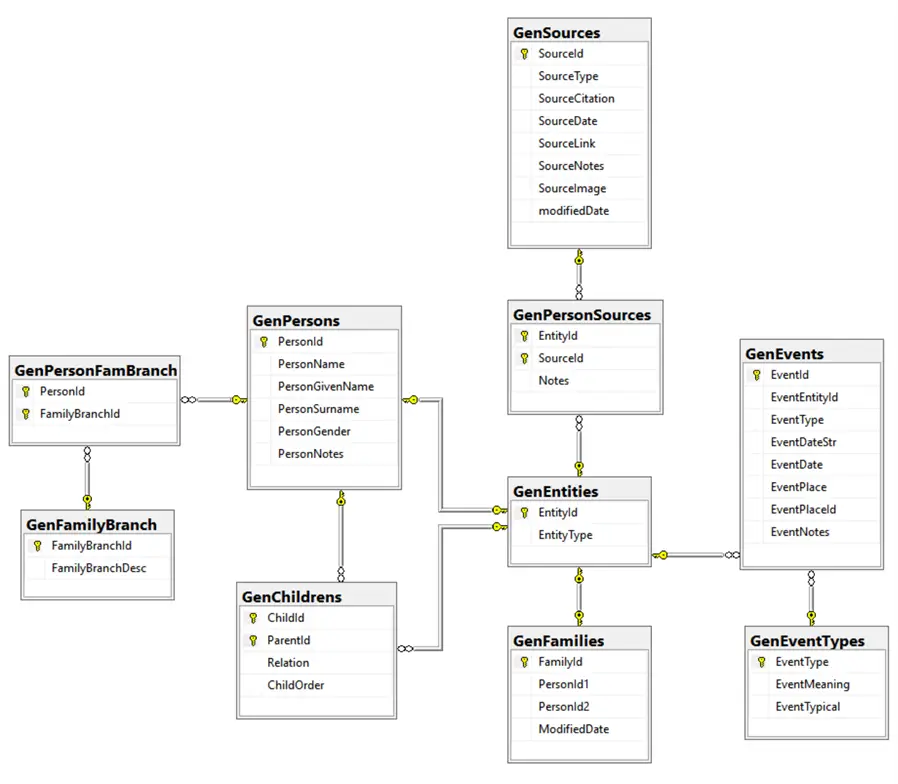
Table for Individuals
-- MSSQLTips (TSQL)
CREATE TABLE [dbo].[GenTree](
[PersonId] [int] NOT NULL,
[FatherId] [int] NULL,
[MotherId] [int] NULL,
[FamId] [int] NULL,
[ChildOrder] [smallint] NULL,
[PersonName] [nvarchar](150) NULL,
[PersonGivenName] [nvarchar](150) NULL,
[PersonSurname] [nvarchar](150) NULL,
[Gender] [char](1) NULL,
[BirthDateStr] [nvarchar](50) NULL,
[BirthDate] [date] NULL,
[BirthPlace] [nvarchar](250) NULL,
[DeathDateStr] [nvarchar](50) NULL,
[DeathDate] [date] NULL,
[DeathPlace] [nvarchar](250) NULL,
[IsDateApproximate] [bit] NULL,
CONSTRAINT [PK_GenTree] PRIMARY KEY CLUSTERED
(
[PersonId] ASC
)WITH (PAD_INDEX = OFF, STATISTICS_NORECOMPUTE = OFF, IGNORE_DUP_KEY = OFF, ALLOW_ROW_LOCKS = ON, ALLOW_PAGE_LOCKS = ON, OPTIMIZE_FOR_SEQUENTIAL_KEY = OFF) ON [PRIMARY]
) ON [PRIMARY]
GO
ALTER TABLE [dbo].[GenTree] ADD CONSTRAINT [DF_GenTree_IsDateAbout] DEFAULT ((0)) FOR [IsDateApproximate]
GOTable for Couples
-- MSSQLTips (TSQL)
CREATE TABLE [dbo].[GenTreeCouples](
[PersonId1] [int] NOT NULL,
[PersonId2] [int] NOT NULL,
[FamilyId] [int] NULL,
[MarriageDateStr] [nvarchar](50) NULL,
[MarriageDate] [date] NULL,
[MarriagePlace] [nvarchar](250) NULL,
[IsDateApproximate] [bit] NULL,
CONSTRAINT [PK_GenTreeCouples] PRIMARY KEY CLUSTERED
(
[PersonId1] ASC,
[PersonId2] ASC
)WITH (PAD_INDEX = OFF, STATISTICS_NORECOMPUTE = OFF, IGNORE_DUP_KEY = OFF, ALLOW_ROW_LOCKS = ON, ALLOW_PAGE_LOCKS = ON, FILLFACTOR = 90, OPTIMIZE_FOR_SEQUENTIAL_KEY = OFF) ON [PRIMARY]
) ON [PRIMARY]
GO
ALTER TABLE [dbo].[GenTreeCouples] ADD CONSTRAINT [DF_GenTreeCouples_IsDateApproximate] DEFAULT ((0)) FOR [IsDateApproximate]
GOTable for Ancestors Path
-- MSSQLTips (TSQL)
CREATE TABLE [dbo].[GenTreeAncestors](
[AncestorLineId] [int] IDENTITY(1,1) NOT NULL,
[AncestorLine] [varchar](800) NULL,
[PersonId] [int] NULL,
[ParentId] [int] NULL,
[FirstId] AS (case when [ancestorline] like '%-%' then left([ancestorline],charindex('-',[ancestorline])-(1)) else [ancestorline] end),
[Depth] [int] NULL,
CONSTRAINT [PK_GenTreeAncestors] PRIMARY KEY CLUSTERED
(
[AncestorLineId] ASC
)WITH (PAD_INDEX = OFF, STATISTICS_NORECOMPUTE = OFF, IGNORE_DUP_KEY = OFF, ALLOW_ROW_LOCKS = ON, ALLOW_PAGE_LOCKS = ON, OPTIMIZE_FOR_SEQUENTIAL_KEY = OFF) ON [PRIMARY]
) ON [PRIMARY]
GOConversion Date Strings to ISO Date
This store procedure tries to convert string dates to ISO format dates. The reason to include an additional column for Date as string is because of the GEDCOM specs for writing dates with qualifier terms like about, before, after, and others. After running it, please adjust the respective column date to whatever it should be or makes sense for those not converted. I only simplified for the ABOUT qualifier, where I converted the year to start on January 1.
-- =============================================
-- Author: SCP - MSSQLTips
-- Create date: 20250410
-- Description: Genealogy Dates to ISO Format
-- =============================================
CREATE OR ALTER PROCEDURE [dbo].[uspGenTreeToIsoDates]
AS
BEGIN
SET NOCOUNT ON;
BEGIN TRY
IF (SELECT COUNT(*)
FROM [dbo].[GenTree]) < 1 BEGIN
PRINT 'No records found!';
RETURN
END;
-- ==============================================================================
UPDATE [dbo].[GenTreeCouples]
SET [MarriageDateStr] = CONCAT('01 JAN ',[MarriageDateStr])
,[IsDateApproximate] = 1
WHERE LEN([MarriageDateStr]) = 4;
UPDATE [dbo].[GenTreeCouples]
SET [MarriageDate] = PARSE(REPLACE([MarriageDateStr],'ABT ','01 JAN') AS date)
,[IsDateApproximate] = CASE WHEN [MarriageDateStr] LIKE '%ABT%' THEN 1 ELSE 0 END
WHERE ISDATE(REPLACE([MarriageDateStr],'ABT ','01 JAN')) = 1;
UPDATE [dbo].[GenTree]
SET [IsDateApproximate] = 1
WHERE [BirthDateStr] LIKE '%ABT%' OR
[DeathDate] LIKE '%ABT%';
UPDATE [dbo].[GenTree]
SET [BirthDateStr] = CONCAT('01 JAN ',[BirthDateStr])
,[IsDateApproximate] = 1
WHERE LEN([BirthDateStr]) = 4;
UPDATE [dbo].[GenTree]
SET [BirthDate] = PARSE(REPLACE([BirthDateStr],'ABT ','01 JAN') AS date)
WHERE ISDATE(REPLACE([BirthDateStr],'ABT ','01 JAN')) = 1;
UPDATE [dbo].[GenTree]
SET [DeathDateStr] = CONCAT('01 JAN ',[DeathDateStr])
,[IsDateApproximate] = 1
WHERE LEN([DeathDateStr]) = 4;
UPDATE [dbo].[GenTree]
SET [DeathDate] = PARSE(REPLACE([DeathDateStr],'ABT ','01 JAN') AS date)
WHERE ISDATE(REPLACE([DeathDateStr],'ABT ','01 JAN')) = 1;
RETURN;
END TRY
BEGIN CATCH
IF @@TRANCOUNT > 0
BEGIN
ROLLBACK TRANSACTION;
END
-- Print error information.
PRINT 'Error: ' + CONVERT(varchar(50), ERROR_NUMBER()) +
', Severity: ' + CONVERT(varchar(5), ERROR_SEVERITY()) +
', State: ' + CONVERT(varchar(5), ERROR_STATE()) +
', Procedure: ' + ISNULL(ERROR_PROCEDURE(), '-') +
', Line: ' + CONVERT(varchar(5), ERROR_LINE());
PRINT ERROR_MESSAGE();
END CATCH;
END
GOPerson Age
This function returns the person’s age based on the person ID.
-- =============================================
-- Author: SCP - MSSQLTips
-- Create date: 20250415
-- Description: Person age by date
-- =============================================
CREATE OR ALTER FUNCTION [dbo].[ufnGenPersonAge]
(@BirthDate date
,@Date date)
RETURNS nvarchar(50)
WITH EXECUTE AS CALLER
AS
BEGIN
DECLARE @Age nvarchar(50)
,@Temp date
,@Years int
,@Months int
,@Days int;
SELECT @Temp = @BirthDate;
SET @Years = DATEDIFF(yy, @Temp, @Date) -
CASE WHEN (MONTH(@BirthDate) > MONTH(@Date)) OR
(MONTH(@BirthDate) = MONTH(@Date) AND
DAY(@BirthDate) > DAY(@Date))
THEN 1
ELSE 0
END;
SET @Temp = DATEADD(yy, @Years, @Temp);
SET @Months = DATEDIFF(m, @Temp, @Date) -
CASE WHEN DAY(@BirthDate) > DAY(@Date)
THEN 1
ELSE 0
END;
SET @Temp = DATEADD(m, @Months, @Temp);
SET @Days = DATEDIFF(d, @Temp, @Date);
SET @Age = CAST(@Years AS nvarchar(3)) + 'y ' +
CAST(@Months AS nvarchar(3)) + 'm ' +
CAST(@Days AS nvarchar(3)) + 'd';
RETURN @Age;
END
GOPerson Birth Date
This function returns the person’s birth date based on the person ID.
-- =============================================
-- Author: SCP - MSSQLTips
-- Create date: 20250415
-- Description: Genealogy Person Birthdate
-- =============================================
CREATE OR ALTER FUNCTION [dbo].[ufnGenPersonBirthDate]
(@PersonId int)
RETURNS date
WITH EXECUTE AS CALLER
AS
BEGIN
DECLARE @BirthDate date;
SELECT @BirthDate = [BirthDate]
FROM [dbo].[GenTree]
WHERE ([PersonId] = @PersonId);
RETURN @BirthDate;
END
GOView for Individuals
CREATE OR ALTER VIEW [dbo].[vGenTree]
AS
SELECT PersonId, FatherId, MotherId, FamId, ChildOrder, PersonName, PersonGivenName, PersonSurname, Gender, BirthDateStr, BirthDate, BirthPlace, DeathDateStr, DeathDate, dbo.ufnGenPersonAge(BirthDate,
DeathDate) AS DeathAge, DeathPlace, IsDateApproximate
FROM dbo.GenTree
GOView for Couples
CREATE OR ALTER VIEW [dbo].[vGenCouples]
AS
SELECT C.FamilyId, F.PersonId AS FatherId, F.PersonName AS FatherName, F.BirthDate AS FatherBirthDate, F.BirthPlace AS FatherBirthPlace, F.DeathDate AS FatherDeathDate, dbo.ufnGenPersonAge(F.BirthDate,
F.DeathDate) AS FatherDeathAge, F.DeathPlace AS FatherDeathPlace, F.IsDateApproximate AS FatherDatesAprox, M.PersonId AS MotherId, M.PersonName AS MotherName, M.BirthDate AS MotherBirthDate,
M.BirthPlace AS MotherBirthPlace, M.DeathDate AS MotherDeathDate, dbo.ufnGenPersonAge(M.BirthDate, M.DeathDate) AS MotherDeathAge, M.DeathPlace AS MotherDeathPlace,
M.IsDateApproximate AS MotherDatesAprox, C.MarriageDate, dbo.ufnGenPersonAge(F.BirthDate, C.MarriageDate) AS FatherMarriageAge, dbo.ufnGenPersonAge(M.BirthDate, C.MarriageDate) AS MotherMarriageAge,
C.MarriagePlace, C.IsDateApproximate AS MarriageIsDateApproximate
FROM dbo.GenTree AS F INNER JOIN
dbo.GenTreeCouples AS C ON F.PersonId = C.PersonId1 INNER JOIN
dbo.GenTree AS M ON C.PersonId2 = M.PersonId
GOPerson Briefing
To have a briefing for a person is to provide a snapshot of essential facts, helping to distinguish individuals and clarify how they are related to other persons across generations.
-- =============================================
-- Author: SCP - MSSQLTips
-- Create date: 20250417
-- Description: Person´s briefing
-- =============================================
CREATE OR ALTER FUNCTION [dbo].[ufnGenPersonBriefing]
(@PersonId int)
RETURNS nvarchar(MAX)
WITH EXECUTE AS CALLER
AS
BEGIN
DECLARE @Marriage nvarchar(MAX) = ''
,@Briefing nvarchar(MAX) = '';
DECLARE @Gen
TABLE ([PersonPronoun] nvarchar(10)
,[PersonName] nvarchar(150)
,[BirthDate] date
,[BirthPlace] nvarchar(150)
,[FatherName] nvarchar(150)
,[FatherAgeBirth] nvarchar(20)
,[MotherName] nvarchar(150)
,[MotherAgeBirth] nvarchar(20)
,[DeathDate] date
,[DeathPlace] nvarchar(150)
,[DeathAge] nvarchar(20)
,[FatherId] int
,[MotherId] int);
DECLARE @GenMarried
TABLE ([EventId] int IDENTITY
,[PersonPronoun] nvarchar(10)
,[PersonAgeMarried] nvarchar(20)
,[SpouseId] int
,[SpouseName] nvarchar(150)
,[SpouseAgeMarried] nvarchar(20)
,[MarriageDate] date
,[MarriagePlace] nvarchar(150)
,[Sons] nvarchar(50)
,[Daughters] nvarchar(50)
,[Childrens] nvarchar(MAX));
-- Person =====================================================================
INSERT INTO @Gen
([PersonPronoun]
,[PersonName]
,[BirthDate]
,[BirthPlace]
,[DeathDate]
,[DeathPlace]
,[DeathAge]
,[FatherId]
,[MotherId])
SELECT CASE WHEN Gender = 'M' THEN 'He' ELSE 'She' END
,[PersonName]
,[BirthDate]
,[BirthPlace]
,[DeathDate]
,[DeathPlace]
,[DeathAge]
,[FatherId]
,[MotherId]
FROM [dbo].[vGenTree]
WHERE [personId] = @PersonId;
-- Couple =====================================================================
INSERT INTO @GenMarried
([PersonPronoun]
,[PersonAgeMarried]
,[SpouseId]
,[SpouseName]
,[SpouseAgeMarried]
,[MarriageDate]
,[MarriagePlace])
SELECT CASE WHEN [FatherId] = @PersonId THEN 'He' ELSE 'She' END
,CASE WHEN [FatherId] = @PersonId THEN [FatherMarriageAge] ELSE [MotherMarriageAge] END
,CASE WHEN [FatherId] = @PersonId THEN [MotherId] ELSE [FatherId] END
,CASE WHEN [FatherId] = @PersonId THEN [MotherName] ELSE [FatherName] END
,CASE WHEN [FatherId] = @PersonId THEN [MotherMarriageAge] ELSE [FatherMarriageAge] END
,[marriageDate]
,[marriagePlace]
FROM [dbo].[vGenCouples]
WHERE [FatherId] = @PersonId OR
[MotherId] = @PersonId
ORDER BY [MarriageDate];
UPDATE @GenMarried
SET [Sons] =
(SELECT COUNT(*)
FROM [dbo].[GenTree]
WHERE [gender] = 'M' AND
([fatherId] = @PersonId AND [motherId] = [SpouseId] OR
[fatherId] = [SpouseId] AND [motherId] = @PersonId))
,[Daughters] =
(SELECT COUNT(*)
FROM [dbo].[GenTree]
WHERE [gender] = 'F' AND
([fatherId] = @PersonId AND [motherId] = [SpouseId] OR
[fatherId] = [SpouseId] AND [motherId] = @PersonId));
UPDATE @GenMarried
SET [Sons] =
CASE
WHEN [Sons] = 0 THEN NULL
WHEN [Sons] = 1 THEN [Sons] + ' son'
WHEN [Sons] > 1 THEN [Sons] + ' sons'
END
,[Daughters] =
CASE
WHEN [Daughters] = 0 THEN NULL
WHEN [Daughters] = 1 THEN [Daughters] + ' daughter'
WHEN [Daughters] > 1 THEN [Daughters] + ' daughters'
END;
UPDATE @GenMarried
SET [Children] =
CASE
WHEN [Sons] IS NULL AND [Daughters] IS NULL THEN ' No children recorded.'
WHEN [Sons] IS NULL AND [Daughters] IS NOT NULL THEN ' They were the parents of at least ' + [Daughters] + '.'
WHEN [Sons] IS NOT NULL AND [Daughters] IS NULL THEN ' They were the parents of at least ' + [Sons] + '.'
WHEN [Sons] IS NOT NULL AND [Daughters] IS NOT NULL THEN ' They were the parents of at least ' + [Sons] + ' and ' + [Daughters] + '.'
ELSE NULL
END;
SELECT @Marriage += CONCAT(CHAR(9),'On ',FORMAT([MarriageDate],'dd MMMM yyyy')
,' in ' + [MarriagePlace] + ',',' at the age of '
,[PersonAgeMarried],' old ',LOWER([PersonPronoun]),' married ',[SpouseName]
,' at the age of ' + [SpouseAgeMarried] + ' old.'
,[Children],CHAR(10))
FROM @GenMarried;
UPDATE @Gen
SET [FatherName] = G.FatherName
,[FatherAgeBirth] = dbo.ufnGenPersonAge(G.FatherBirthDate,[BirthDate])
,[MotherName] = G.MotherName
,[MotherAgeBirth] = dbo.ufnGenPersonAge(G.MotherBirthDate,[BirthDate])
FROM [dbo].[vGenCouples] G
WHERE [@Gen].[FatherId] = G.FatherId AND
[@Gen].[MotherId] = G.MotherId;
SELECT @Briefing = CONCAT('BRIEFING'
,CHAR(10),'Name: ',CHAR(9),[PersonName]
,CHAR(10),'Birth: ',CHAR(9),FORMAT([BirthDate],'dd MMMM yyyy'),' - ' + [BirthPlace]
,CHAR(10),'Father: ',CHAR(9),[FatherName],', aged ' + [FatherAgeBirth] + ' old at his birth '
,CHAR(10),'Mother: ',CHAR(9),[MotherName],', aged ' + [MotherAgeBirth] + ' old at his birth.'
,CHAR(10),'Marriage: ',@Marriage
,'Death: ',CHAR(9),FORMAT([DeathDate],'dd MMMM yyyy')
,' - ' + [DeathPlace],' at the age of ' + [DeathAge] + ' old.')
FROM @Gen;
RETURN @Briefing;
END
GOPerson Life Span
It is a reference to a person’s Birth-to-Death range.
-- =============================================
-- Author: SCP - MSSQLTips
-- Create date: 20250414
-- Description: Genealogy Person Lifespan
-- =============================================
CREATE OR ALTER FUNCTION [dbo].[ufnGenPersonLifeSpan]
(@PersonId int)
RETURNS nvarchar(25)
WITH EXECUTE AS CALLER
AS
BEGIN
DECLARE @Lifespan nvarchar(25)
,@Birth nvarchar(10)
,@Death nvarchar(10);
SELECT @Birth = YEAR(BirthDate)
,@Death = YEAR(DeathDate)
FROM [dbo].[GenTree]
WHERE ([PersonId] = @PersonId);
SET @Lifespan = COALESCE(@Birth,'?') + '-' + COALESCE(@Death,'?');
IF @Lifespan = '?-?'
SET @Lifespan = '-';
SET @Lifespan = ' (' + @Lifespan + ')';
RETURN @Lifespan;
END
GOPerson Name
This function returns the person’s name based on the person ID.
-- =============================================
-- Author: SCP - MSSQLTips
-- Create date: 20250423
-- Description: Person name
-- =============================================
CREATE OR ALTER FUNCTION [dbo].[ufnGenPersonName]
(@PersonId int)
RETURNS nvarchar(150)
AS
BEGIN
DECLARE @PersonName nvarchar(150);
SELECT @PersonName = [PersonName]
FROM [dbo].[GenTree]
WHERE [PersonId] = @PersonId;
RETURN @PersonName;
END
GOAncestors Update
Every time you enter a new person, you must run the code to update the ancestor table.
-- =============================================
-- Author: SCP - MSSQLTips
-- Create date: 20250423
-- Description: Ancestor table update
-- =============================================
CREATE OR ALTER PROCEDURE [dbo].[uspGenAncestors]
WITH EXECUTE AS CALLER
AS
BEGIN;
TRUNCATE TABLE [dbo].[GenTreeAncestors];
WITH ctetable (id, pid, depth, parents) AS
(SELECT S.personId
,S.personId
,0 AS depth
,CONVERT(varchar(MAX), S.personId) AS parents
FROM [dbo].[GenTree] AS S
UNION ALL
SELECT S2.personId
,p.id
,p.depth + 1 AS depth
,CONCAT(p.parents,'->',S2.personId)
FROM ctetable AS p JOIN
[dbo].[GenTree] AS S2 ON
(S2.fatherId = p.id OR S2.motherId = p.id)
WHERE (p.id IS NOT NULL))
INSERT INTO [dbo].[GenTreeAncestors]
([AncestorLine]
,[PersonId]
,[ParentId]
,[Depth])
SELECT DISTINCT
[parents],[id],[pId],[depth]--,@Ancestor
FROM [ctetable]
ORDER BY [depth];
RETURN;
END
GOGEDCOM Import
The following store procedure will import the GED file directly to our tables. Note: I will use only the retrieval of basic information, but the process is the same for the missing ones.
-- =============================================
-- Author: SCP - MSSQLTips
-- Create date: 20250410
-- Description: GEDCOM v5.5.5 to SQL Genealogy
-- =============================================
CREATE OR ALTER PROCEDURE [dbo].[uspGenTreeImport]
(@PathAndFile nvarchar(500))
AS
BEGIN
SET NOCOUNT ON;
BEGIN TRY
-- ==============================================================================
TRUNCATE TABLE [dbo].[GenTree];
TRUNCATE TABLE [dbo].[GenTreeCouples];
-- ==============================================================================
DECLARE @GedLine nvarchar(500)
,@PersonId int = -1
,@FamId int = -1
,@FatherId int
,@MotherId int
,@PersonName nvarchar(150)
,@PersonGivenName nvarchar(150)
,@PersonSurname nvarchar(150)
,@Gender char(1)
,@BirthDate nvarchar(50)
,@BirthPlace nvarchar(250)
,@DeathDate nvarchar(50)
,@MarriagePlace nvarchar(250)
,@MarriageDate nvarchar(50)
,@DeathPlace nvarchar(250)
,@CoupleId int
,@Section nvarchar(50)
,@Data nvarchar(MAX)
,@Sql nvarchar(MAX)
,@ChildOrder smallint = 0;
DECLARE @GenData
TABLE (Item int IDENTITY
,GedLine nvarchar(500));
-- ==============================================================================
SET @Sql = CONCAT('SELECT @DataOut = BULKCOLUMN FROM OPENROWSET(BULK '''
,@PathAndFile,''', SINGLE_CLOB) AS Gen;');
EXEC sp_executesql @Sql,N'@DataOut nvarchar(MAX) OUTPUT',@DataOut = @Data OUTPUT;
INSERT INTO @GenData
SELECT value
FROM string_split(@Data,CHAR(10));
UPDATE @GenData
SET GedLine = REPLACE(GedLine,CHAR(13),'');
-- INDIVIDUAL ===================================================================
DECLARE CrsIndi CURSOR FAST_FORWARD READ_ONLY FOR
SELECT GedLine
FROM @GenData;
OPEN CrsIndi
FETCH NEXT FROM CrsIndi INTO @GedLine
WHILE @@FETCH_STATUS = 0
BEGIN
IF @GedLine LIKE '%@ INDI' OR @GedLine LIKE '%@ FAM' BEGIN
IF @PersonId >= 0
INSERT INTO [dbo].[GenTree]
([PersonId]
,[FatherId]
,[MotherId]
,[PersonName]
,[PersonGivenName]
,[PersonSurname]
,[Gender]
,[BirthDateStr]
,[BirthPlace]
,[DeathDateStr]
,[DeathPlace])
VALUES (@PersonId
,@FatherId
,@MotherId
,@PersonName
,@PersonGivenName
,@PersonSurname
,@Gender
,@BirthDate
,@BirthPlace
,@DeathDate
,@DeathPlace);
IF @GedLine NOT LIKE '%@ FAM%'
SET @PersonId = REPLACE(REPLACE(@GedLine,'0 @I',''),'@ INDI','');
ELSE
SET @PersonId = -1;
SET @PersonName = NULL;
SET @PersonGivenName = NULL;
SET @PersonSurname = NULL;
SET @Gender = NULL;
SET @BirthDate = NULL;
SET @BirthPlace = NULL;
SET @DeathDate = NULL;
SET @DeathPlace = NULL;
END
IF @GedLine LIKE '%@ INDI'
SET @Section = 'INDI';
IF @GedLine = '1 BIRT'
SET @Section = 'BIRT';
IF @GedLine = '1 CHR'
SET @Section = 'CHR';
IF @GedLine = '1 DEAT'
SET @Section = 'DEAT';
IF @GedLine = '1 MARR'
SET @Section = 'MARR';
IF @GedLine = '1 CHAN'
SET @Section = 'CHAN';
IF @GedLine = '1 DIV'
SET @Section = 'DIV';
IF @GedLine = '1 EVEN'
SET @Section = 'EVEN';
IF @GedLine = '1 GRAD'
SET @Section = 'GRAD';
IF @GedLine = '1 BURI'
SET @Section = 'BURI';
IF @GedLine LIKE '%@ REPO'
SET @Section = 'REPO';
IF @GedLine LIKE '1 EDUC'
SET @Section = 'EDUC';
IF @GedLine LIKE '1 NAME%' AND @PersonName IS NULL
SET @PersonName = REPLACE(REPLACE(@GedLine,'1 NAME ',''),'/','');
IF @GedLine LIKE '2 GIVN%' AND @PersonGivenName IS NULL
SET @PersonGivenName = REPLACE(@GedLine,'2 GIVN ','');
IF @GedLine LIKE '2 SURN%' AND @PersonSurname IS NULL
SET @PersonSurname = REPLACE(@GedLine,'2 SURN ','');
IF @GedLine LIKE '1 SEX%' AND @Gender IS NULL
SET @Gender = REPLACE(@GedLine,'1 SEX ','');
IF @GedLine LIKE '2 DATE%' AND @Section = 'BIRT' AND @BirthDate IS NULL
SET @BirthDate = REPLACE(@GedLine,'2 DATE ','');
IF @GedLine LIKE '2 PLAC%' AND @Section = 'BIRT' AND @BirthPlace IS NULL
SET @BirthPlace = REPLACE(@GedLine,'2 PLAC ','');
IF @GedLine LIKE '2 DATE%' AND @Section = 'DEAT' AND @DeathDate IS NULL
SET @DeathDate = REPLACE(@GedLine,'2 DATE ','');
IF @GedLine LIKE '2 PLAC%' AND @Section = 'DEAT' AND @DeathPlace IS NULL
SET @DeathPlace = REPLACE(@GedLine,'2 PLAC ','');
-- FAMILY =======================================================================
IF @GedLine LIKE '%@ FAM' OR @GedLine LIKE '%TRLR%' BEGIN
SET @Section = 'FAM';
IF @FamId >= 0 AND @FatherId IS NOT NULL AND @MotherId IS NOT NULL BEGIN
INSERT INTO [dbo].[GenTreeCouples]
([PersonId1]
,[PersonId2]
,[MarriageDateStr]
,[MarriagePlace]
,[FamilyId])
VALUES (@FatherId
,@MotherId
,@MarriageDate
,@MarriagePlace
,@FamId);
END;
IF @GedLine <> '0 TRLR'
SET @FamId = REPLACE(REPLACE(@GedLine,'0 @F',''),'@ FAM','');
SET @MarriageDate = NULL;
SET @MarriagePlace = NULL;
SET @ChildOrder = 0;
END
IF @GedLine LIKE '1 HUSB%'
SET @FatherId = REPLACE(REPLACE(@GedLine,'1 HUSB @I',''),'@','');
IF @GedLine LIKE '1 WIFE%'
SET @MotherId = REPLACE(REPLACE(@GedLine,'1 WIFE @I',''),'@','');
IF @GedLine LIKE '2 DATE%' AND @Section = 'MARR'
SET @MarriageDate = REPLACE(@GedLine,'2 DATE ','');
IF @GedLine LIKE '2 PLAC%' AND @Section = 'MARR'
SET @MarriagePlace = REPLACE(@GedLine,'2 PLAC ','');
IF @GedLine LIKE '1 CHIL%' BEGIN
SET @ChildOrder += 1;
UPDATE [dbo].[GenTree]
SET [FatherId] = @FatherId
,[MotherId] = @MotherId
,[ChildOrder] = @ChildOrder
WHERE [PersonId] = REPLACE(REPLACE(@GedLine,'1 CHIL @I',''),'@','');
END;
FETCH NEXT FROM CrsIndi INTO @GedLine
END
CLOSE CrsIndi
DEALLOCATE CrsIndi
-- DATES ========================================================================
UPDATE [dbo].[GenTreeCouples]
SET [MarriageDateStr] = CONCAT('01 JAN ',[MarriageDate])
,[IsDateApproximate] = 1
WHERE LEN([MarriageDateStr]) = 4;
UPDATE [dbo].[GenTreeCouples]
SET [MarriageDate] = PARSE(REPLACE([MarriageDateStr],'ABT ','01 JAN') AS date)
,[IsDateApproximate] = CASE WHEN [MarriageDateStr] LIKE '%ABT%' THEN 1 ELSE 0 END
WHERE ISDATE(REPLACE([MarriageDateStr],'ABT ','01 JAN')) = 1;
UPDATE [dbo].[GenTree]
SET [IsDateApproximate] = 1
WHERE [BirthDateStr] LIKE '%ABT%' OR
[DeathDate] LIKE '%ABT%';
UPDATE [dbo].[GenTree]
SET [BirthDateStr] = CONCAT('01 JAN ',[BirthDateStr])
,[IsDateApproximate] = 1
WHERE LEN([BirthDateStr]) = 4;
UPDATE [dbo].[GenTree]
SET [BirthDate] = PARSE(REPLACE([BirthDateStr],'ABT ','01 JAN') AS date)
WHERE ISDATE(REPLACE([BirthDateStr],'ABT ','01 JAN')) = 1;
UPDATE [dbo].[GenTree]
SET [DeathDateStr] = CONCAT('01 JAN ',[DeathDateStr])
,[IsDateApproximate] = 1
WHERE LEN([DeathDateStr]) = 4;
UPDATE [dbo].[GenTree]
SET [DeathDate] = PARSE(REPLACE([DeathDateStr],'ABT ','01 JAN') AS date)
WHERE ISDATE(REPLACE([DeathDateStr],'ABT ','01 JAN')) = 1;
-- ==============================================================================
UPDATE [dbo].[GenTree]
SET [FamId] =
(SELECT [FamilyId]
FROM [dbo].[GenTreeCouples]
WHERE [PersonId1] = [FatherId] AND
[PersonId2] = [MotherId]);
-- ==============================================================================
SELECT [PersonId]
,[FatherId]
,[MotherId]
,[FamId]
,[ChildOrder]
,[PersonName]
,[PersonGivenName]
,[PersonSurname]
,[Gender]
,[BirthDateStr]
,[BirthDate]
,[BirthPlace]
,[DeathDateStr]
,[DeathDate]
,[DeathPlace]
,[IsDateApproximate]
FROM [dbo].[GenTree];
RETURN;
END TRY
BEGIN CATCH
IF @@TRANCOUNT > 0
BEGIN
ROLLBACK TRANSACTION;
END
-- Print error information.
PRINT 'Error: ' + CONVERT(varchar(50), ERROR_NUMBER()) +
', Severity: ' + CONVERT(varchar(5), ERROR_SEVERITY()) +
', State: ' + CONVERT(varchar(5), ERROR_STATE()) +
', Procedure: ' + ISNULL(ERROR_PROCEDURE(), '-') +
', Line: ' + CONVERT(varchar(5), ERROR_LINE());
PRINT ERROR_MESSAGE();
END CATCH;
END
GOGEDCOM Export
The following store procedure will export the data of our two tables, generating a new GED file content. After running the store procedure, copy the entire GED line content to your file, using the NOTEPAD app, and save it with the extension GED. Observe the encoding that best fits your needs. You can also save the content directly to a file. Use the SSMS option Results to File. But, in this case, after saving it with the extension GED, you have to remove any extra lines included by the SSMS.
-- =============================================
-- Author: SCP - MSSQLTips
-- Create date: 20250410
-- Description: SQL Genealogy to GEDCOM v5.5.5
-- =============================================
CREATE OR ALTER PROCEDURE [dbo].[uspGenTreeExport]
AS
BEGIN
SET NOCOUNT ON;
BEGIN TRY
IF (SELECT COUNT(*)
FROM [dbo].[GenTree]) < 1 BEGIN
PRINT 'No records found!';
RETURN
END;
DECLARE @PersonId nvarchar(10)
,@Name nvarchar(150)
,@Surname nvarchar(50)
,@Gender char(1)
,@Birth nvarchar(10)
,@BirthPlace nvarchar(250)
,@Death nvarchar(10)
,@DeathPlace nvarchar(250)
,@FatherId nvarchar(10)
,@MotherId nvarchar(10)
,@Couple nvarchar(20)
,@FamId nvarchar(10)
,@MarriagePlace nvarchar(250)
,@MarriageDate nvarchar(50);
DECLARE @GenFamily
TABLE (GedItem int IDENTITY
,GedLine nvarchar(500));
INSERT INTO @GenFamily
VALUES ('0 HEAD')
,('1 GEDC')
,('2 VERS 5.5.5')
,('2 FORM LINEAGE-LINKED')
,('1 CHAR UTF-8')
,('1 LANG English')
,('1 SUBM @SUB1@')
,('0 @SUB1@ SUBM');
-- INDIVIDUAL ===================================================================
DECLARE CrsIndi CURSOR FAST_FORWARD READ_ONLY FOR
SELECT [PersonId]
,[PersonName]
,[PersonSurname]
,[Gender]
,[BirthDate]
,[BirthPlace]
,[DeathDate]
,[DeathPlace]
,[FatherId]
,[MotherId]
,[FamId]
FROM [dbo].[GenTree];
OPEN CrsIndi
FETCH NEXT
FROM CrsIndi
INTO @PersonId,@Name,@Surname,@Gender,@Birth,@BirthPlace
,@Death,@DeathPlace,@FatherId,@MotherId,@FamId;
WHILE @@FETCH_STATUS = 0
BEGIN
SET @Name = TRIM(REPLACE(@Name,@Surname,''));
INSERT INTO @GenFamily
VALUES ('0 @I' + @PersonId + '@ INDI')
,('1 NAME ' + @Name + ' /' + @Surname + '/')
,('2 SURN ' + @Surname)
,('2 GIVN ' + @Name)
,('1 SEX ' + @Gender);
IF @Birth IS NOT NULL
INSERT INTO @GenFamily
VALUES ('1 BIRT')
,('2 DATE ' + @Birth);
IF @BirthPlace IS NOT NULL AND LEN(@BirthPlace) > 0
INSERT INTO @GenFamily
VALUES ('2 PLAC ' + @BirthPlace);
IF @Death IS NOT NULL
INSERT INTO @GenFamily
VALUES ('1 DEAT')
,('2 DATE ' + @Death);
IF @Death IS NOT NULL AND @DeathPlace IS NOT NULL AND LEN(@DeathPlace) > 0
INSERT INTO @GenFamily
VALUES ('2 PLAC ' + @DeathPlace);
IF @FamId IS NOT NULL
INSERT INTO @GenFamily
VALUES ('1 FAMC @F' + @FamId + '@');
INSERT INTO @GenFamily
SELECT CONCAT('1 FAMS @F',[FamilyId],'@')
FROM [dbo].[GenTreeCouples]
WHERE [personId1] = @PersonId OR
[personId2] = @PersonId;
FETCH NEXT
FROM CrsIndi
INTO @PersonId,@Name,@Surname,@Gender,@Birth,@BirthPlace
,@Death,@DeathPlace,@FatherId,@MotherId,@FamId;
END
CLOSE CrsIndi
DEALLOCATE CrsIndi
-- FAMILY =======================================================================
DECLARE CrsFam CURSOR FAST_FORWARD READ_ONLY FOR
SELECT [PersonId1]
,[PersonId2]
,[FamilyId]
,COALESCE(CONVERT(nvarchar(50),[MarriageDate]),[MarriageDateStr])
,[MarriagePlace]
FROM [dbo].[GenTreeCouples]
ORDER BY [FamilyId];
OPEN CrsFam
FETCH NEXT
FROM CrsFam
INTO @FatherId,@MotherId,@FamId,@MarriageDate,@MarriagePlace;
WHILE @@FETCH_STATUS = 0
BEGIN
INSERT INTO @GenFamily
VALUES ('0 @F' + @FamId + '@ FAM')
,('2 HUSB @I' + @FatherId + '@')
,('2 WIFE @I' + @MotherId + '@');
IF @MarriageDate IS NOT NULL OR @MarriagePlace IS NOT NULL BEGIN
INSERT INTO @GenFamily
VALUES ('1 MARR')
,('2 DATE ' + @MarriageDate)
,('2 PLAC ' + @MarriagePlace);
END;
INSERT INTO @GenFamily
SELECT CONCAT('1 CHIL @I',PersonId,'@')
FROM [dbo].[GenTree]
WHERE [FamId] = @FamId
ORDER BY [ChildOrder];
FETCH NEXT
FROM CrsFam
INTO @FatherId,@MotherId,@FamId,@MarriageDate,@MarriagePlace;
END
CLOSE CrsFam
DEALLOCATE CrsFam
-- ==============================================================================
INSERT INTO @GenFamily
VALUES ('0 TRLR');
-- ==============================================================================
SELECT [GedLine]
FROM @GenFamily
WHERE [GedLine] IS NOT NULL
ORDER BY [GedItem];
RETURN;
END TRY
BEGIN CATCH
IF @@TRANCOUNT > 0
BEGIN
ROLLBACK TRANSACTION;
END
-- Print error information.
PRINT 'Error: ' + CONVERT(varchar(50), ERROR_NUMBER()) +
', Severity: ' + CONVERT(varchar(5), ERROR_SEVERITY()) +
', State: ' + CONVERT(varchar(5), ERROR_STATE()) +
', Procedure: ' + ISNULL(ERROR_PROCEDURE(), '-') +
', Line: ' + CONVERT(varchar(5), ERROR_LINE());
PRINT ERROR_MESSAGE();
END CATCH;
END
GOAHNENTAFEL Numbering (Ancestor)
In German, AHNENTAFEL means ancestor table. It is an ascending numbering system for ordering and identifying direct ancestors, starting with the subject of the tree and working backwards. Every direct ancestor is given a number, starting with 1 for the subject, 2 to his father, 3 to his mother, 4 to paternal grandfather, 5 to paternal grandmother, 6 and 7 to maternal grandparents, and so on. In summary, male ancestors receive even numbers and female ancestors the odd numbers.
-- =============================================
-- Author: SCP - MSSQLTips
-- Create date: 20250414
-- Description: Ahnentafel Numbering (Ancestor)
-- =============================================
CREATE OR ALTER PROCEDURE [dbo].[uspGenAhnentafel]
(@DescendantId int)
WITH EXECUTE AS CALLER
AS
BEGIN;
/*
Ahnentafel for Father = 2 * parent
Ahnentafel for Mother = 2 * parent + 1
*/
WITH CteAncestor AS
(SELECT PersonId
,PersonName + [dbo].[ufnGenPersonLifeSpan] (PersonId) AS PersonName
,CAST(1 AS bigint) AS Ahnentafel
,0 AS [GenLevel]
FROM [dbo].[GenTree]
WHERE [PersonId] = @DescendantId
UNION ALL
SELECT p.FatherId
,p.PersonName + [dbo].[ufnGenPersonLifeSpan] (p.PersonId)
,a.Ahnentafel * 2
,[GenLevel] + 1
FROM [dbo].[GenTree] p JOIN CteAncestor a ON
p.PersonId = a.PersonId
WHERE p.FatherId IS NOT NULL
UNION ALL
SELECT p.MotherId
,p.PersonName + [dbo].[ufnGenPersonLifeSpan] (p.PersonId)
,a.Ahnentafel * 2 + 1
,[GenLevel] + 1
FROM [dbo].[GenTree] p JOIN CteAncestor a ON
p.PersonId = a.PersonId
WHERE p.MotherId IS NOT NULL)
SELECT p.PersonId
,p.PersonName + [dbo].[ufnGenPersonLifeSpan] (p.PersonId) [PersonName]
,a.Ahnentafel
,a.GenLevel
FROM [dbo].[GenTree] p JOIN CteAncestor a ON
p.PersonId = a.PersonId
ORDER BY [Ahnentafel];
RETURN;
END
GOD’ABOVILLE Numbering (Descendant)
It is a decimal-based descendant numbering format to track an individual’s position within a family tree, starting from a common ancestor.
-- =============================================
-- Author: SCP
-- Create date: 20250414
-- Description: DAboville Numbering (Descendant)
-- =============================================
CREATE OR ALTER PROCEDURE [dbo].[uspGenDAboville]
(@AncestorId int)
WITH EXECUTE AS CALLER
AS
BEGIN;
WITH CteDescendants AS
(SELECT PersonId
,FatherId
,CONCAT(PersonName,[dbo].[ufnGenPersonLifespan] (PersonId)) AS PersonName
,CONVERT(nvarchar(MAX),1) AS DAboville
,BirthDate
,0 AS [GenLevel]
FROM [dbo].[GenTree]
WHERE [PersonId] = @AncestorId
UNION ALL
SELECT p.PersonId
,p.FatherId
,CONCAT(p.PersonName,[dbo].[ufnGenPersonLifespan] (p.PersonId))
,CONCAT(d.DAboville,'.'
,(ROW_NUMBER() OVER (PARTITION BY p.FatherId ORDER BY p.BirthDate)))
,p.BirthDate
,[GenLevel] + 1
FROM [dbo].[GenTree] p JOIN CteDescendants d ON
(p.FatherId = d.PersonId or p.motherId = d.PersonId))
SELECT p.PersonId
,CONCAT(P.PersonName,[dbo].[ufnGenPersonLifespan] (P.PersonId)) AS [PersonName]
,REPLICATE('. ', a.GenLevel) + a.DAboville AS [DAboville]
,a.GenLevel
FROM [dbo].[GenTree] p JOIN CteDescendants a ON
p.PersonId = a.PersonId
ORDER BY a.DAboville;
RETURN;
END
GOKinship
This is the relationship between family members. I am not covering all possibilities, but the most important ones. (I did not work with any in-law relatives. Since English is not my native-language, there are probably better words to use. I did not take into consideration the gender to define the exact word to use, in the case of uncle or aunt, and niece or nephew.
-- =============================================
-- Author: SCP - MSSQLTips
-- Create date: 20250423
-- Description: Family relationship
-- =============================================
CREATE OR ALTER FUNCTION [dbo].[ufnGenKinship]
(@Ego int
,@Target int)
RETURNS nvarchar(150)
AS
BEGIN;
DECLARE @Kinship nvarchar(150);
IF EXISTS
(SELECT 1
FROM [dbo].[GenTreeCouples]
WHERE [personId1] IN (@Ego,@Target) AND
[personId2] IN (@Ego,@Target))
SET @Kinship = 'Spouse';
ELSE BEGIN
DECLARE @p1 int = 0
,@p2 int = 0;
SELECT TOP 1 @p2 = COALESCE([depth],0)
FROM [dbo].[GenTreeAncestors]
WHERE [PersonId] = @Ego AND
[FirstId] IN
(SELECT [FirstId]
FROM [dbo].[GenTreeAncestors]
WHERE [PersonId] = @Target)
ORDER BY [depth];
SELECT TOP 1 @p1 = [depth]
FROM [dbo].[GenTreeAncestors]
WHERE [PersonId] = @Target AND
[FirstId] IN
(SELECT [FirstId]
FROM [dbo].[GenTreeAncestors]
WHERE [PersonId] = @Ego)
ORDER BY [depth];
SELECT @Kinship =
CASE
WHEN @p1 = 1 AND @p2 = 0 THEN 'Parent'
WHEN @p1 = 1 AND @p2 = 1 THEN 'Siblings'
WHEN @p1 = 1 AND @p2 = 2 THEN 'Niece/nephew'
WHEN @p1 = 1 AND @p2 = 3 THEN 'Great-niece/nephew'
WHEN @p1 = 1 AND @p2 > 3 THEN CONCAT('Great-(x',@p2-2,')-niece/nephew')
WHEN @p1 = 2 AND @p2 = 0 THEN 'Grandparent'
WHEN @p1 = 3 AND @p2 = 0 THEN 'Great-grandparent'
WHEN @p1 > 3 AND @p2 = 0 THEN CONCAT('Great-(x',@p1-2,')-grandparent')
WHEN @p1 = 2 AND @p2 = 1 THEN 'Uncle/Aunt'
WHEN @p1 = 3 AND @p2 = 1 THEN 'Great-uncle/aunt'
WHEN @p1 > 3 AND @p2 = 1 THEN CONCAT('Great-(x',@p1-2,')-uncle/aunt')
WHEN @p1 = 2 AND @p2 = 2 THEN 'Cousin'
WHEN @p1 = 3 AND @p2 = 3 THEN '2nd cousin'
WHEN @p1 = 4 AND @p2 = 4 THEN '3rd cousin'
WHEN @p1 > 4 AND @p1 = @p2 THEN CONCAT(@p1-1,'th cousin')
WHEN @p1 = 0 AND @p2 = 1 THEN 'Children'
WHEN @p1 = 0 AND @p2 = 2 THEN 'Grandchildren'
WHEN @p1 = 0 AND @p2 = 3 THEN 'Great-grandchildren'
WHEN @p1 = 0 AND @p2 > 3 THEN CONCAT('Great-(x',@p2-2,')-grandchildren')
ELSE 'Ego'
END;
END
RETURN @Kinship;
END
GOExamples
Import from GRAMPS Sample
If you want to test the GEDCOM import and export features, after installing the GRAMPS software, you are going to find a sample GED file at:
-- MSSQLTips (FILE PATH)
C:\Program Files\GrampsAIO64-6.0.0\share\doc\gramps\example\gedcom\sample.gedRun the statement below to upload the data to the SQL Server. Remember that any data will be deleted before loading the new one.
-- MSSQLTips (TSQL)
EXEC [dbo].[uspGenTreeImport]
@PathAndFile = N'C:\Program Files\GrampsAIO64-6.0.0\share\doc\gramps\example\gedcom\sample.ged';
GO
If you find problems with encoding, open the sample file in Notepad and save it in ANSI format to fix it, and run the above statement again.

Do the adjustments from the columns date string to date as you wish, once calculated values uses those columns.
Export to GEDCOM File
-- MSSQLTips (TSQL)
EXEC [dbo].[uspGenTreeExport]
GOWill result in:
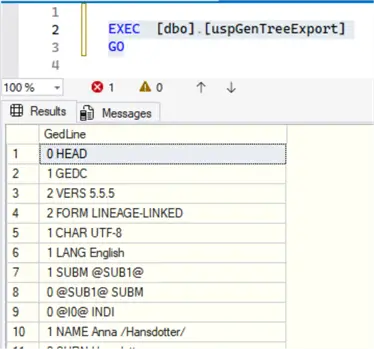
Copy the column GEDLINE to a notepad and save it with the name you wish, but with the extension GED.
Open the GRAMPS program, click on Family Trees (1), then on New (2), then on Load Family Tree (3).
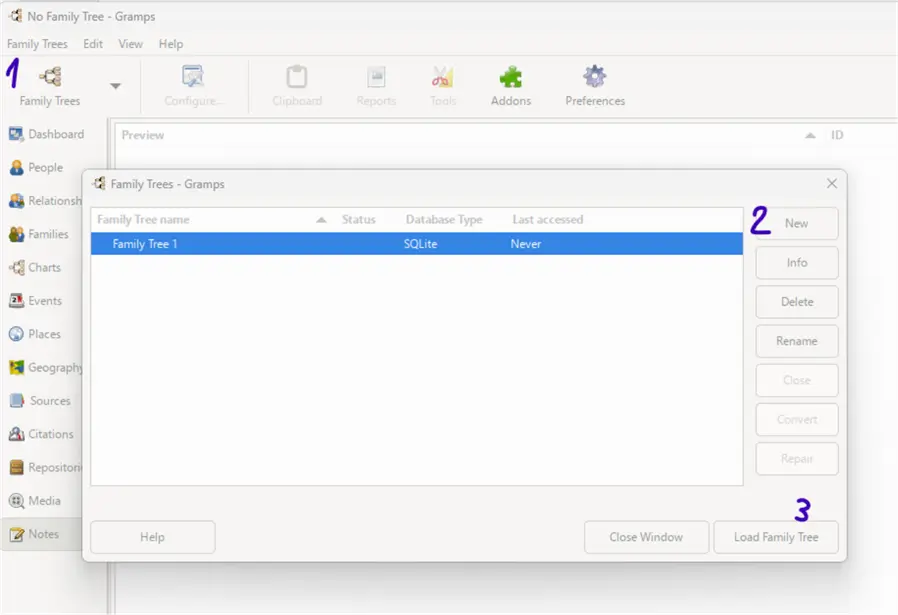
Click on Family Trees and then Import; a window will open. Go to where you save your file and import it. You should see the messages Results done and No errors detected.
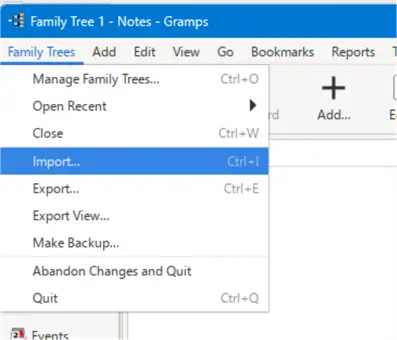
Go to the dashboard and explore the loaded data.
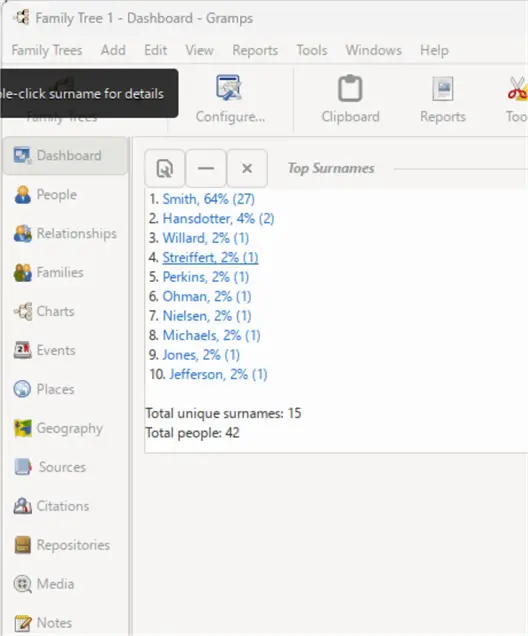
AHNENTAFEL Number
-- MSSQLTips (TSQL)
EXEC [dbo].[uspGenAhnentafel] @DescendantId = 35
GOWill result in:
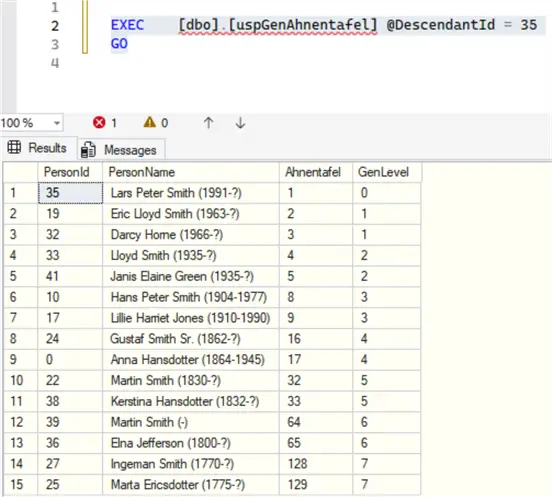
D´ABOVILLE Number
-- MSSQLTips (TSQL)
EXEC [dbo].[uspGenDAboville] @AncestorId = 0
GOThis will result in a good way to show and visualize the genealogical tree, starting from ANA (level 0), her sons (level 1), her grandsons (level 2), and so on. Some genealogical books report individuals using this numbering system.
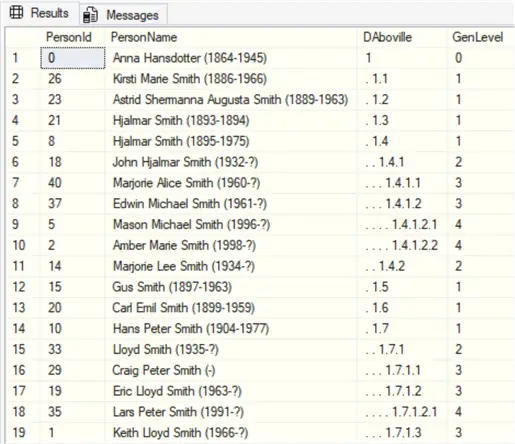
Individual Briefing
-- MSSQLTips (TSQL)
SELECT [dbo].[ufnGenPersonBriefing] (8) AS Briefing
GOThis will result in this text, copied below in a text document:

If you want, you can use the same logic used for children to identify and report how many brothers and sisters an individual had.
KINSHIP
First of all, update the ancestors executing:
-- MSSQLTips (TSQL)
EXEC [dbo].[uspGenAncestors]
GOChoose two persons’ ID from the ABOVILLE or AHNENTAFEL results and run the code.
-- MSSQLTips (TSQL)
DECLARE @personId1 int = 35
,@personId2 int = 32;
SELECT [dbo].[ufnGenPersonName] (@personId1)
+ ' is the ' + [dbo].[ufnGenKinship] (@personId1,@personId2) + ' of '
+ [dbo].[ufnGenPersonName] (@personId2) AS Kinship;
GOIt will show the relationship between them:
- Lars Peter Smith is the Child of Darcy Horne
Next Steps
There are a lot more features, but this covers the main ones.


